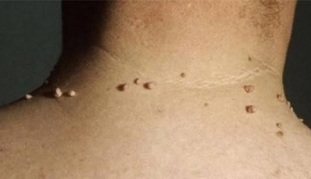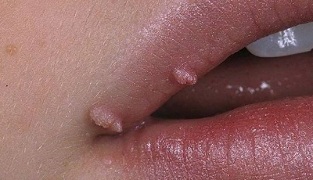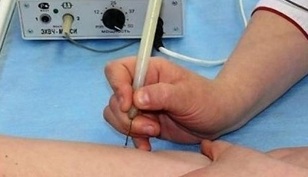If nipple-like growths appear on the trunk, limbs or face, it is always an unpleasant surprise for a person. These are benign formations on the skin that can be either multiple or single. Papillomas on the body, unfortunately, are a very common disease that develops due to human papillomavirus (HPV) infection, but treating them in modern conditions is not a problem.
What are papillomas on the body?
Papillomavirus is a benign tumor that grows from the tissues of the squamous epithelium. It acts as a drop or papilla on the skin, mucous membranes, and can affect a person's internal organs. There are more than 30 types and subspecies of HPV that can easily enter the human body. Depending on the type of pathogen, different groups of papillomas form on the body. They differ in growth rate, appearance, location.
Papillomavirus can be detected anywhere in the body:
- natural wrinkles: groin, armpits, mammary glands, lower abdomen;
- face: eyelids, near the eyes, near the mouth;
- torso: back, stomach, neck, hands, feet;
- genitals: vagina, penis area;
- internal organs: intestines, stomach, bladder, esophagus, larynx, windpipe.
What a papilloma looks like

HPV can look different from the outside. These are usually oval growths on the body or rounded processes on the skin that resemble a papilla.
They can be small (1-5mm), medium (1cm), large (1-3cm) and huge (over 3cm). The texture of the papules is relatively loose and soft. Interstices between blood vessels are often visible on the surface.
The color is mostly flesh and all kinds of brown. There are cases when papillomas were blue, purple, and even black and black in color.
Why papillomas occur
These growths on the body are viral in nature. The infection is transmitted to a healthy person through contact with a carrier. Both men and women are equally susceptible to infection, but are affected differently by the virus. The weaker sex may feel burning and itching in the genital area, bleeding, and other extraneous discharges from the vagina. Sometimes the disease is associated with syphilis, chlamydia, herpes, and other sexually transmitted diseases.
Men are not afraid of certain types of the virus that are dangerous to women (16, 18). However, the stronger sex is a carrier of infection. The papillomas on the genitals, frenulum and glans or in the urethra are painless benign neoplasms of type 6 and 11 that must be removed. Penile cancer is very rare.
Methods of infection
The infection is particularly active in fitness studios, swimming pools, saunas and spas. Other reasons for the appearance of papillomas on the body are sexual intercourse, childbirth (from mother to child).
Here are some more ways to get infected with human papillomavirus:
- when kissing, because the virus is contained in saliva;
- when using personal items of the infected person;
- in the case of insufficient processing of medical instruments.
Types and types
The number of types of neoplasms in the body is estimated to be dozen. The doctors have divided them into 5 groups and combined them according to color, symptoms and risk of malignant degeneration of the skin cells:

- Simple papillomas.They are also known as vulgar warts. Has the greatest distribution. The first sign of HPV is a small amount of growth on the skin. During the development process, it is transformed into a dark keratinized tubercle. It is localized both in groups and individually. Favorite places for localization are hands, the lower part of the face.
- Flat papillomas.A characteristic feature is a group accumulation of growths. Flat papillomas do not have a bulge, but are painted dark. The main place of distribution is the upper body, the genital area.
- genital warts.The place is the mucous membranes of the body and genitals. These strains are at risk of cancer. The main cause of genital warts is sexual intercourse.
- Filiform papillomas.In the scientific world they were given the name "Acrochords". A distinctive feature of this species is the leg that supports the mole. Acrochords are senile growths because they appear primarily on the body of middle-aged and elderly people.
- Internal papillomas.This subgroup includes all neoplasms that develop on the internal organs. It is impossible to independently identify genital warts of this group, this requires special diagnostics. The presence of a disease can cause symptoms.
Virus risk
An infection with human papillomavirus is generally not a major health risk. However, some species are able to degenerate into a malignant tumor. Non-oncogenic papillomas can also cause a lot of inconvenience when they start to grow on the back, mouth, or groin area, for example. They are often injured, after which ulcers and wounds remain on the body, open to infection. Condylomas of the bladder often trigger an inflammatory process, and growth in the uterine cavity sometimes leads to female infertility.
Diagnosis
If you notice a papilloma on your body, you should consult a dermatologist. After the initial examination, the doctor will send the patient for a cytological examination and a blood test (tumor markers, HPV, DNA). This is necessary to determine pathological processes and determine the nature of the viral infection in relation to the risk of oncogenic disease. If a tumor of the cervix appears, a colposcopy is required.
How to get rid of papillomas on the body
There are many methods of treating growth. It is better to stop the growth of papillomas on the body during complex therapy. It is impossible to completely eliminate human papillomavirus from the body, but it is possible to reduce its activity for a long time by increasing immunity. The proliferation of papules is treated with surgical and therapeutic methods. Folk recipes also help with HPV infections.
How to get rid of HPV with medication
When HPV first appears, doctors prescribe medication to reduce the chances of infecting others. Various drugs are used to fight viral infections in gynecology and dermatology.
Laser distance
People often resort to surgical removal of growths if they look unaesthetic or cause discomfort, e. g. B. if they are in intimate places, in the neck area or in natural skin folds. Laser removal of papillomas takes a few minutes. Its essence lies in the use of a device that burns out a neoplasm. There is no skin contact, which guarantees a high level of safety in the process. The advantages of the technique include the absence of blood loss, painlessness, and speedy recovery.
Disadvantages of laser treatment:
- high costs;
- Impossibility of examining a distant growth.
Liquid nitrogen
Removal of neoplasms with liquid nitrogen (cryodestruction) is no less effective. Although the procedure is simple, it requires preparation: thoroughly wash the areas of the skin to be frozen and shave the hair, if any. To apply nitrogen, the specialist uses a metal cotton swab, which is dipped into a container with a clear liquid. After that, contact with the papilloma occurs within 1-5 seconds. The recovery takes place within 2-3 days. The advantages of the procedure are simplicity and speed of the procedure, high efficiency.
Disadvantages of the method:
- the likelihood of damage to the surrounding tissue;
- pain during the line;
- Error removing large growths,
Treatment of papillomas with the radio wave method
The essence of technology is to influence the structure of high-frequency radio waves, which are completely harmless to health. To remove the papilloma, the doctor fixes the beam on the problem point for a few seconds. After the procedure, drug therapy is prescribed. The advantage of the radio wave method lies in its versatility - different types of warts, moles and papillomas on any part of the skin easily disappear. It can even be used on difficult areas like the eye area. There are no scars after the procedure.
Disadvantages of the method:
- high costs;
- is not effective at removing large growths.
Electrocoagulation

A medical procedure in which benign growths are removed using a precisely coordinated electrical current. Electrocoagulation is carried out using a device equipped with a loop and an electrode that are heated to high temperatures. The manipulation takes place under local anesthesia. In children, the removal is performed under general anesthesia. After the tumor has burned off, the skin is treated with an antiseptic. The process takes 5-10 minutes.
The advantages of the method include the safety and effectiveness of removing a skin disease, preventing the likelihood of infection, and the possibility of histology.
Disadvantages of electrocautery:
- Risk of scar remains;
- relative pain;
- long recovery period (up to 10 days);
- relapses are possible at the place of removal.
How to remove birthmarks and papillomas using folk remedies
According to the reviews of patients who have been HPV carriers, using alternative prescriptions after drug therapy and / or removal methods will help clear the virus faster.
At home, with external manifestations of papillomas, the following methods are effective:
- celandine.It is necessary to lubricate the skin with a neoplasm with freshly squeezed vegetable juice several times a day.
- banana.In order to speed up the therapy, the pulp must be applied to the neoplasms. Banana is especially effective on small plantar warts.
Prevention
The following preventive measures should prevent a relapse:
- to have regular checkups for HPV;
- Avoid occasional sexual contact.
- Maintaining immunity: eating right, temperament;
- control the growth and change in the shape of untreated papillomas; Vaccinate
- with 2% serum (three times within six months).













































































